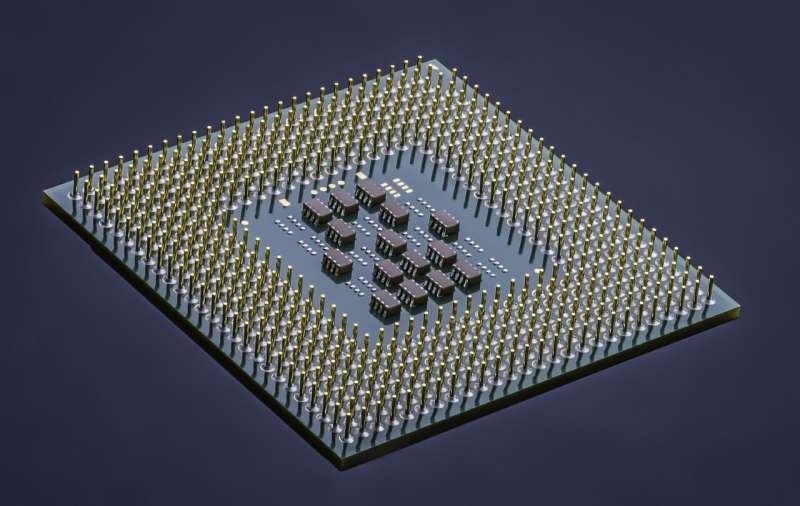Team demonstrates molecular electronics sensors on a semiconductor chip

The first molecular electronics chip has been developed, realizing a 50-year-old goal of integrating single molecules into circuits to achieve the ultimate scaling limits of Moore's Law. Developed by Roswell Biotechnologies and a multi-disciplinary team of leading academic scientists, the chip uses single molecules as universal sensor elements in a circuit to create a programmable biosensor with real-time, single-molecule sensitivity and unlimited scalability in sensor pixel density. This innovation, appearing this week in a peer-reviewed article in the Proceedings of the National Academy of Sciences (PNAS), will power advances in diverse fields that are fundamentally based on observing molecular interactions, including drug discovery, diagnostics, DNA sequencing, and proteomics.
"Biology works by single molecules talking to each other, but our existing measurement methods cannot detect this," said co-author Jim Tour, Ph.D., a Rice University chemistry professor and a pioneer in the field of molecular electronics. "The sensors demonstrated in this paper for the first time let us listen in on these molecular communications, enabling a new and powerful view of biological information."
The molecular electronics platform consists of a programmable semiconductor chip with a scalable sensor array architecture. Each array element consists of an electrical current meter that monitors the current flowing through a precision-engineered molecular wire, assembled to span nanoelectrodes that couple it directly into the circuit. The sensor is programmed by attaching the desired probe molecule to the molecular wire, via a central, engineered conjugation site. The observed current provides a direct, real-time electronic readout of molecular interactions of the probe. These picoamp-scale current-versus-time measurements are read out from the sensor array in digital form, at a rate of 1000 frames per second, to capture molecular interactions data with high resolution, precision and throughput.
"The goal of this work is to put biosensing on an ideal technology foundation for the future of precision medicine and personal wellness," added Roswell co-Founder and Chief Scientific Officer Barry Merriman, Ph.D., the senior author of the paper. "This requires not only putting biosensing on chip, but in the right way, with the right kind of sensor. We've pre-shrunk the sensor element to the molecular level to create a biosensor platform that combines an entirely new kind of real-time, single-molecule measurement with a long-term, unlimited scaling roadmap for smaller, faster and cheaper tests and instruments."
The new molecular electronics platform detects multi-omic molecular interactions at the single-molecule scale, in real-time. The PNAS paper presents a wide array of probe molecules, including DNA, aptamers, antibodies, and antigens, as well as the activity of enzymes relevant to diagnostics and sequencing, including a CRISPR Cas enzyme binding its target DNA. It illustrates a wide range of applications for such probes, including the potential for rapid COVID testing, drug discovery and proteomics.
The paper also presents a molecular electronics sensor capable of reading DNA sequence. In this sensor, a DNA polymerase, the enzyme that copies DNA, is integrated into the circuit, and the result is direct electrical observation of the action of this enzyme as it copies a piece of DNA, letter by letter. Unlike other sequencing technologies that rely on indirect measures of polymerase activity, this approach achieves direct, real-time observation of a DNA polymerase enzyme incorporating nucleotides. The paper illustrates how these activity signals can be analyzed with machine learning algorithms to allow reading of the sequence.
"The Roswell sequencing sensor provides a new, direct view of polymerase activity, with the potential to advance sequencing technology by additional orders of magnitude in speed and cost," said Professor George Church, a co-author of the paper, member of the National Academy of Sciences, and a Roswell Scientific Advisory Board member. "This ultra scalable chip opens up the possibility for highly distributed sequencing for personal health or environmental monitoring, and for future ultra-high throughput applications such as Exabyte-scale DNA data storage."
More information: Molecular electronics sensors on a scalable semiconductor chip: A platform for single-molecule measurement of binding kinetics and enzyme activity, Proceedings of the National Academy of Sciences (2022). DOI: 10.1073/pnas.2112812119.
Journal information: Proceedings of the National Academy of Sciences
Provided by Roswell Biotechnologies





















